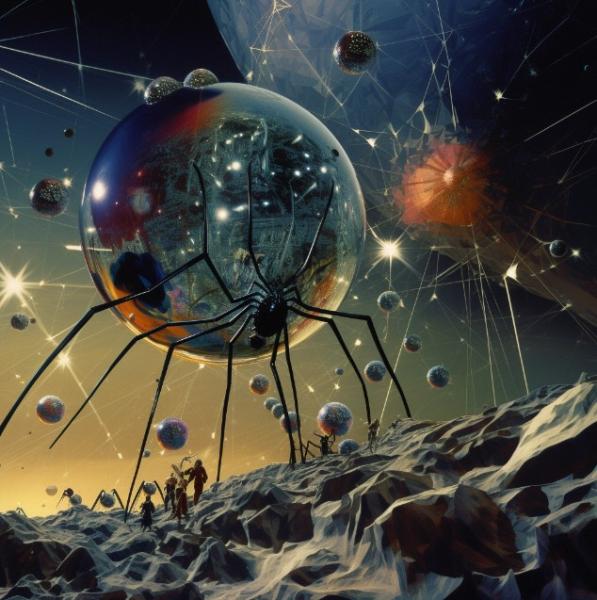BY LETTER
Space Spiders
Technology > Application > Construction
Technology > Technology Type or Material > Gengineering
Technology > Technology Levels > High Tech / Hitech
Technology > Technology Type or Material > Organic/Biotech
Science > Biology > Zoology
Technology > Technology Type or Material > Gengineering
Technology > Technology Levels > High Tech / Hitech
Technology > Technology Type or Material > Organic/Biotech
Science > Biology > Zoology
 Image from Keith Wigdor and Midjourney AI | |
| Spider-shaped morphs are particularly well-adapted to working in space | |
By the Federation Era many space-based spidermorphs were sentient or fully sophont. As well as artificial robot or vec spidermorphs, an increasing number of spidermorphs were biologically-based, using bodies based on Terran species such as the Hobo spider. Vacuum-adapted spidermorphs have thick impermeable exoskeletons, and need to carry all their metabolic requirements such as oxygen, food and water with them while operating in deep space. If a biont space spider becomes separated from their resource cache, they will shut down and go into suspended animation until rescued, while transmitting a distress signal by various means.
The small, subsentient splice morph known as bucky spiders were developed in the Integration Era as sources of carbon nanofibre cloth; larger morphs (often fully sophont) are employed in megascale construction.
In the Current Era many sophonts choose to adopt a space-spider bodymorph on a temporary or permanent basis; space spidermorphs are often but not always eight-legged, and modern space-spiders utilise Syntechnology which has blurred the boundaries between biotech and hylotech almost completely. Space spiders can be found in many sizes, from micro-scale to giant. Vacuum-adapted Spidermorph cultures are found in many locations throughout the Terragen Sphere, spinning webs between habitats and among the ring particles orbiting gas giants; one particularly widespread example is the Hellspider culture, spidermorphs adapted to extreme conditions. In contrast the Imtonasi are arachnid/humanoid hybrid morphs, who display many features of both bauplans.
Spidermorphed remotes and avatars are quite often directly controlled by transapient postspiders in their various projects, and sometimes become independent sophonts in their own right. The Silk God in the Red Star M'Pire is an example of a very large project that includes many spidermorphed participants.
Because the arachnomorph bodyplan is quite common among independently-evolved xenobiota, a significant number of alien spider-like creatures have been discovered on various natural garden worlds throughout the Terragen Sphere. In several cases these organisms have been provolved by Terragen agents and some have joined the ranks of the space-spider community; among these are space-adapted Pspyders which originated on the planet Trees.
Related Articles
- Arachnid
- Bucky Spiders - Text by Steve Bowers
Small spidersplices with adapted spinnerets producing buckyfibre on demand - controlled by bionano (mostly Zoeific clades) or hylonano neural implants - used in small scale construction and the manufacture of fabrics. - Hellspiders
- Hobo Sapiens
- Imtonasi
- Pspyder
- Silk God, The
Appears in Topics
Development Notes
Text by Steve Bowers
Initially published on 02 March 2003.
Initially published on 02 March 2003.






